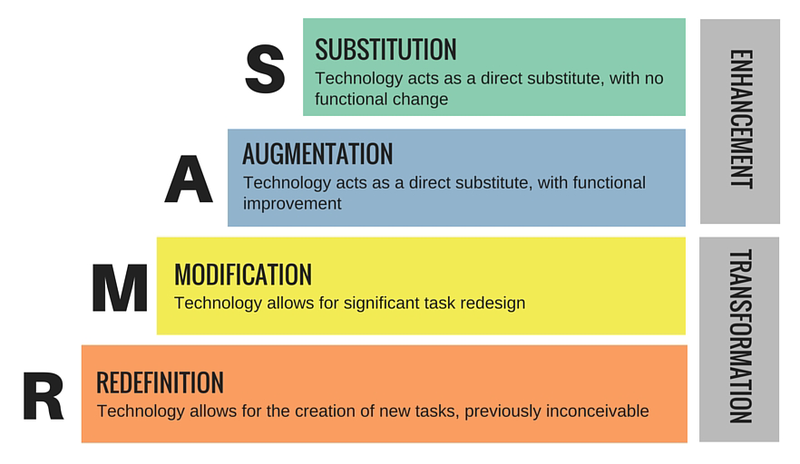Applying the SAMR model to aid your digital transformation
Last updated:
Is our technology transforming the way we deliver our curriculum and what can we do to find out?
Digital teaching and learning models
Models can help you identify which digital practices have become embedded in your curriculum and whether they are starting to bring about digital transformation. One such model is SAMR and it has received a lot of attention in recent times.
What is SAMR?
SAMR (substitution, augmentation, modification and redefinition) was developed by Dr R. Puentedura, following research into how the use of digital technology was transforming classroom-based teaching and learning.
The diagram below explains the four categories.

The SAMR model categories - text version
Enhancement:
- Substitution
Technology acts as a direct substitute, with no functional change - Augmentation
Technology acts and a direct substitute, with functional change
Transformation:
- Modification
Technology allows for significant task redesign - Redefinition
Technology allows for the creation of new tasks, previously inconceivable
Enhancement:
- Substitution
Technology acts as a direct substitute, with no functional change - Augmentation
Technology acts and a direct substitute, with functional change
Transformation:
- Modification
Technology allows for significant task redesign - Redefinition
Technology allows for the creation of new tasks, previously inconceivable
The first two categories, substitution and augmentation, describe a situation where the technology is either directly replacing an existing process or has replaced an older technology, but with little gain. Think about how interactive whiteboards replaced overhead projectors. Ok, the technology was more advanced, but the teaching mostly remained the same. Where digital use matches substitution or augmentation, the technology is said to be enhancing the existing teaching practice.
The next two categories, modification and redefinition, describe how digital use has led to a significant change in the way teaching and learning is planned and delivered. If the introduction of technology has created a brand new practice, then redefinition has taken place. Collectively, these two categories are more likely to promote digital transformation.
Applying SAMR to digital practice
Talk to people and they'll tell you that their overriding desire for technology is to see it transform the student experience. So, how can you use SAMR to achieve this?
We could use SAMR to carry out a simple benchmarking exercises against the available technology for learning and teaching. However, there’s a risk that this diverts our attention to the technology rather than the outcome of our effort to change the way we deliver learning and teaching.
A more useful exercise would be to use SAMR as an audit tool to assess how the use of technology is shaping teaching and learning practice. This would provide valuable insights for individual teachers, while assisting leaders to identify where the investment in digital practice is bringing about worthwhile benefits, for example, with better management of resources.
How can SAMR inform the next steps?
Once we know how technology is shaping our learning and teaching practice, it can be used to inform our plans for innovation.
Start by asking ‘how can we use SAMR to extend our practice and improve the student experience?’
Teachers could audit a specific example where their use of technology is just substituting or augmenting practice. Alternatively, you might choose to use SAMR to improve the procurement of new technology by asking whether the investment in technology is likely to lead to worthwhile digital transformation.
As you become familiar with SAMR, it’s helpful not to see SAMR as hierarchical – that redefinition is the goal for the application of all technology. There will be situations when it’s appropriate for technology to substitute or modify an existing practice.
Alternative models
A few other models you may be familiar with are the TPACK (technological pedagogical and content knowledge) or the RAT (replacement, amplification and transformation) model.